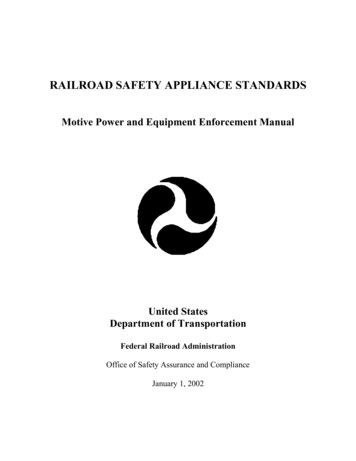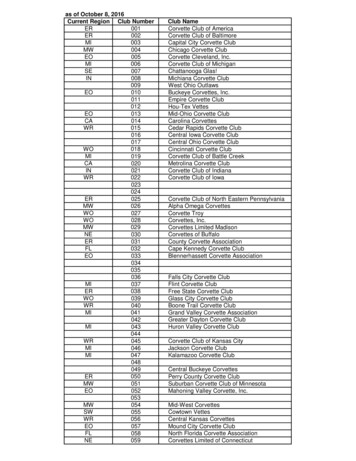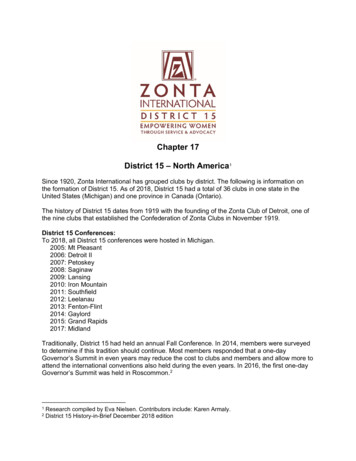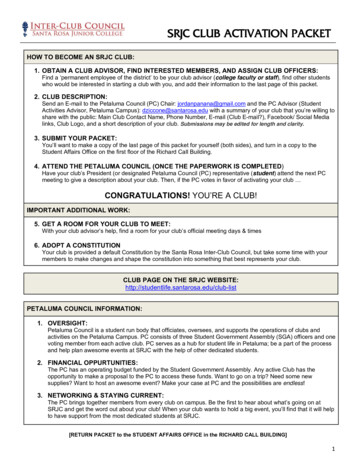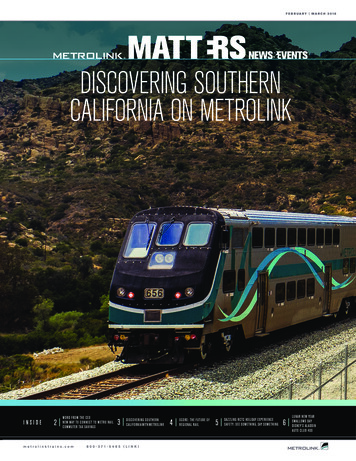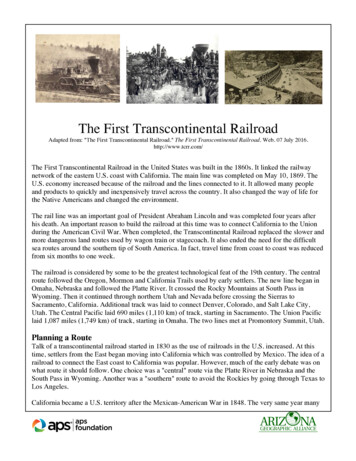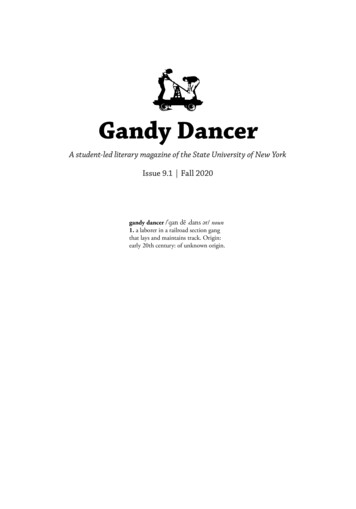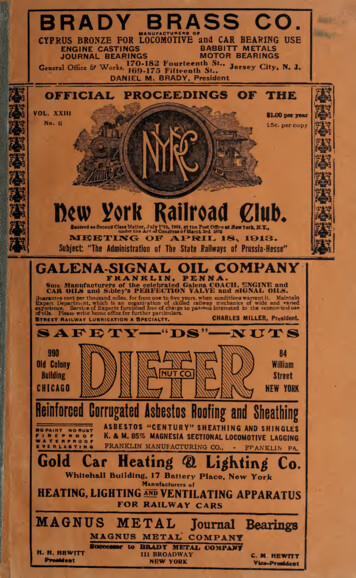
Transcription
BRADY BRASS CO.MANUFACTURERSOfCYPRUS BRONZE FOR LOCOMOTIVE and CAR BEARING USEENGINE CASTINGSJOURNAL BEARINGSBABBITT METALSMOTOR BEARINGSGeneral Office 8? Work., ‘eg’.1, F?f”en*h‘JerSey City* NDANIEL M. BRADY, PresidentOFFICIALPROCEEDINGSOF THEVOL. XXIIINo. 691*00 per year15c. per copynew VorK Railroad Club.Entered a* 8econd Class Matter, July l"th, 1904, at toe Post Office at New York, N.Y.,under the Art of Congress o f March 3rd 1879MEETING OF APRIL 18, 1013.Subject: “The Administration of The State Railways of Prussia-Hesse”GALENA-SIGNAL OIL COMPANYFRANKLIN, PENNA.Sole Manufacturers of the celebrated Galena COACH, ENGINE andCAR OILS and Sibley’s PERFECTION VALVE and SIGNAL OILS.Guarantee cost per thousand miles, for from one to five years, when conditions warrant it. MaintainExpert Department, which is an organisation of skilled railway mechanics of wide and variedexperience. Service of Experts furnished free of charge to patrons interested in the economical useof oils. Please write home office for further particulars.Street Railway Lubrication a Specialty.CHARLES MILLER, President.SAFETYITS99084Old ColonyBuildingCHICAGOWilliamStreetNEW YORKReinforced Corrugated Asbestos Roofing and Sheathingwo paint'no rust\ "T \ J ;„00 JKVERLASTINQASBESTOS “CENTURY” SHEATHING AND SHINGLESK. & M. 85% MAGNESIA SECTIONAL LOCOMOTIVE LAGGINGFRANKLIN MANUFACTURING CO.,FP AN KLIN PA.Gold Car HeatingLighting Co.Whitehall Building* 17 Battery Place, New YorkManufacturers ofHEATING, LIGHTING and VENTILATING APPARATUSFOR RAILWAY CARSMAGNUSMETALJournal BearingsMAGNUS METAL COMPANYto BRADY METAL COMPACTH. H. MB WITTPmMeat111 BROADWAYNEW YORKC. M. HEWITTVtM-Prmftdent
THE WESTERN AIR DUMP CARS(Built in 12, 16, 20 and 30 yard sizes)Hold all Records forDUMP GAR EFFICIENCYIn these cars are combined all the celebrated Western features, such as theinvaluable loose hinge connection, the steep dumping angle, automatic pivoted sideboards, malleable castings, patented automatic air dumping device, etc. Featuresrha t make them ideal dump cars for main line work. Outlast any other type of dumpcars and have no equal for rapidity and economy of operation.Other cars described in our catalog. Write for it.WESTERNWHEELEDMAIN OFFICE, AURORA, ILL.SCRAPERCOMPANYFulton Bide., Hudson Terminal, 50 Church St., N. Y. City.JENKINS BROS. VALVESWhen you make out your requisitions, do you specify“Jenkins” or “Jenkins Bros.” Valves? Are you awareof the difference, so there can be no substitution? Do youknow why it is easier and more economical to maintainsatisfactory service with the Jenkins Bros. Valves, fittedwith renewable discs, than ordinary metal seated valves?These points are explained in our handy booklet entitled—“Facts about Jenkins Bros. Valves.” May we send you acopy? A postal request will bring it by return mail.JENKINS BROS.NEW YORKBOSTONPHILADELPHIACHICAGODIXON'SAIR BRAKE GRAPHITEGRAPHITE PIPE JOINT COMPOUNDSILICA-GRAPHITE PAINTThree Dixon Products recognized as R. R. standardsLiterature and samples sent on requestManufactured only byJoseph Dixon Crucible Company, Jersey City, N. J.Established 1827
of theDew York Railroad ClubPublished for every month, except July, August and September, by the NewYork Railroad Club, Harry D. Vought, Secretary 95 Liberty St., New York City. 1.00 Per Year.vol.xxiii.i - Cents per Copy.New York, N. Y.,May,1913no. 6.OFFICERS, 1912-1913President,E. CHAMBERLIN,Mgr. Equip’t. Clearing HouseN. Y. Central LinesFirst Vice-President.GEORGE W. WILDIN,M.S., N. Y„ N. H.&H. R.R.Second Vice-President,C. W. HUNTINGTON,G.S.C. R.R. of N.J.Third Vice-President,FREDERICK C. SYZE,T. M., B. & O. R. R., St. George, S. I.Treasurer,R. M. DIXON,Pres., Safety Car Heating andLighting Co.Secretary,HARRY D. VOUGHT,95 Liberty Street.A. E. Mitchell.H. H. Vreeland.Executive Members,- JAMES MILLIKEN,S. M. P., P. B. & W. R. R.,Wilmington, Del. (2 years)BURTON. P. FLORY,5. M. P., N. Y., O. & W. R. R.Middletown, N. Y. (3 years)Finance Committee,CHARLES SHULTS,Coatesville Rolling Mills Co. (1 year)B. A. HEGEMAN, Jr.Pres., U. S. Metal & Mfg. Co.12 years).SAMUEL G. ALLEN,V.-P., Franklin Railway Supply Co.(3 years)J. F. Deems. W. G. Besler.Frank Hedley.Past Presidents.H. S. Hayward.Attention of members is especially called to the library of 50,000 volumes and 400current technical periodicals, in the Engineering Societies’ Building, No. 29West 39th Street, which is open to all from 9 a. m. to 9 p. m., except Sundaysand holidays. Special privileges will be accorded on presentation of yourmembership card
SS'O'TDigitized by the Internet Archivein 2017 with funding fromUniversity of Illinois Urbana-Champaign onofOOcunn
PROCEEDINGS OF THE NEW YORK RAILROAD CLUBat meeting held at the Engineering Societies’ Building,29 West 39th Street, New York City,Friday, April 18, 19i3.The meeting was called to order by the President, Mr. Eugene Chamber lin, at 8.30 P. M.The names of those who registered in attendance are as follows:Adamson, G. W.Armstrong, J. R. C.Arter, W. D.Adams, H. H.Abel, G. T.Barnett, Stephen D.Bevan, Thos. D.Baumbush, A. J.Best, W. N.Black, Robt.Brower, R. M.Boucher, William H.Banks, W. C.Brady, Daniel M.Beach, J. W.Bernard, R.Brangs, P. H.Baush, T. V.Boyer, Warren L.Brown, Geo. J.Barry, Frank J.Bauman, John H.Barbey, F. A.Basford, G. M.Byrns, RobertBrazee, F. O.Conroy, Jas.Chambers, C. E.Cloke, GeorgeCoon, C. J.Cunningham, W. J.Coote, J. M.Campbell, John D.Cooke, D. E.Curren, G. W.Chamberlin, W.Cherry, J. M.Carr, E. T, M.Coleman, Jilson J.Cotton, W. A.Cooper, R. S.Curtis, ElliottCampbell, N. A.Chase, C. P.Chamberlin, EugeneDeems, E. M.Dellert, W. H.Donecker, H. C.Dressel, F. W.Damon, Wm. H.Del Mar, Wm. A.Davidson, J. EdgarDewson, E. H.Drew, FrankDroege, J. A.Demarest, G. L.Davis, E. G.Distelhurst, H. D.Dakin, A. H., Jr.Davis, E. W.Donovan, William J.Dayton, George E.Ellicott, C. R.Ellicott, J. R.Estabrook, W. H.Eliot, H. H.Estey, S. J.Eltz, Baron P. vonFoss, Chas. W.Flory, Burton P.Fowler, Geo. L.Green, F. L.Grant, H. L.Gandolfo, J. H.Geiger, Arthur W.Gemunder, ArthurGardner, G. C., Jr.Gassaway, F. S.Garland, N. M.Gray, H. A.Gernert, H.Gannon, M. F.Gillies, Wm. H.Hilferty, C. D.Hunpertovel, H. L.Hegeman, H. A.Hults, John H.
3122Henkel, C. C.Harper,- B.Hedley, FrankHessenbruch, G. E.Hartough, E. W.Haring, G. E.Hoskinson, H. S.Harwood, Geo. A.Hulse, Geo. E.Hine, CharlesHurlbut, B. E.Hickey, Charles A.Hulme, J. W.Hayes, Ross F.Hedley, E. M.Hickerson, G. A.Hutchinson, E. D.Hammett, H. G.Hope, W. C.Higgins, S.Huntington, C. W.Isham, H. S.Illig, Louis J.Jones, W. F.Johnson, A. R.Jones, P. T.Keenan, C. E.Killeen, G. C.Ketcham, F. O.Keller, JosephKeiser, C. B.Kent, F. S.Kay, A. J.Kennan, C. E.Kemp, C. G.Kaylor, W. G.Kelleher, EdmundKarel, FrederickKlumpp, C. S.Lillis, De F.Leach, C. E.Lewis, K. R.Lochamer, Fred A.Lange, T. F.Leslie, S. InglisLatey, H. N.Litchfield, N.Lewis, Arthur S.Lawsing, Dr. G. CondeLong, RobertLingeman, H. B.Locke, A. V.McCracken, Jno. T.McCoy, W. K.McCuen, C. F.McCoy, C. I.McGough, S. J.McClintock, Jno. D.McGinness, H. S.McGloin, MaxwellMcManus, Thos. F.McCleary, James T.Miller, B. E.Munson, C. E.Melvin, Chas. G.Munsell, H. A.Malette, W. C.Munshull, P. H.Montgomery, HughMurphy, J. D.Mason, E. R.Musier, E. M.Martin, C. W.Martin, SamuelMilliken, J.Maxfield, H. H.Moon, R. F.Mitchell, Philip J.Marble, J. E.Morris, J. M., Jr.Melville, L. B.Molineux, L. E.Morse, Frank L.Meek, J. E.Meredith, J. W.Myers, C. F.Moore, A. C.Nelson, G. A.Neale, F. A.Newell, H. A.Nicol, George A.Norris, J. B.O’Brien, Osmond P.Oatley, H. B.O’Connor, Philip J.Olds, Fred L.Palmer, L. H.Parsons, R. H.Pierce, Chas. F.Potter, R. R.Partington, JamesPaxson, AtwoodPrice, Geo. A.Quigg, H. J.Quigg, E. A.Romaine, C.Rink, Geo. W.Robbins, A. E.Rogers, J. H.Rumney, W. H.Reid, JohnReid, J. J.Robbins, MillerRoberts, G. H.Rhodes, M.Robinson, D. E.Rhodes, R. S.Regan, J. H.Robinson, John R.Reynard, H. J.Stoddard, G. C.Smith, F. G.Sweeley, E. H.Shipman, A. J.Sachs, S.Smith, F. H.Soltan, F. W.Spedell, G. M., Jr.Smith, P. W. J.Shults, CharlesShaughnessy, T. H.Strait, W. G.See, P. V.Slenker, C. A.Sharp, E. W.Smith, E. B.Strohm, H. C.Stout, J. B.Stevens, R. N.Stevens, D. F.Soper, C. W.
3123Steel, R. A.Smith, Chas. V.Schrader, J. R.Strong, James B.Snow, W. W.Shults, F. K.Strausse, M. H.Sinclair, J. J.Smith, A. E.Scharwenka, A. V.Strickland, A. H.Stocks, Carl W.Sutton, W. S.Scott, C. W.Simmons, E. A.Syze, Frederick C.Thomas, Richard L.Thurston, J. L.Tomicke, V. G.Toomey, J. J.Toby, S. T.Thompson, H. C.Turner, H. N.Thake, John A.Troxell, J. M.Teufer, J. A., Sr.Thompson, C. F.Usherwood, Geo. B.Vreeland, H. H.Vought, Harry D.Van Beuren, W. B.Wellman, H. C.Wildin, G. W.Weidenmuller, J. W.Willets, A. M.Winship, James G.Weld, E. F.Waitt, Arthur M.Wurtz, FrederickWatres, L. S.Ward, John E.Wood, W. K.Wheeler, Wm. B.Wilkinson, W. H.Wood, R. C.Wilder, C. W.Walker, Chas. H.Wampler, Wm.Weisbrod, J. F.Whiteford, A. M.Wade, E. B. Weis, F. A.Wilson, J. W.Waterman, G. O.Yardley, C. B., Jr.Young, A. R.Zeller, F. B.Zimmerman, Wm. F.Zoerner, C. E.The PRESIDENT—The meeting will please come to order. If thegentlemen now standing in the rear of the hall will step forward there are anumber of seats in front we would like you to occupy. If we can get large,presentable men near to us and where we can look at them frequently, itgives us courage.The roll call will be dispensed with, as it has been provided for by theattendance cards. The reading of the minutes of the meeting of March 21st,1913, will be omitted, as the proceedings have been printed and distributedto the members.You have probably heard both these remarks many times before. Weare about to have them stereotyped.It is our pleasure to announce as the committee on subjects for the en suing year, Mr. R. M. Dixon, Mr. W. G. Besler and Mr. Frank Hedley.We also announce that the committee on the Electrical Night for theensuing year has been re-appointed and remains as it existed last year.The paper of the evening is by William J. Cunningham, Assistant Pro fessor of Transportation, of Harvard University, and the subject is: “Ad ministration of the State Railways of Prussia-Hesse.” If I did not get thatlast pronunciation quite right, it is my fault. Mr. Waitt, did it sound properly?Mr. WAITT—That sounded good.That sounded Deutsch.The PRESIDENT—(continuing) Then it affords us pleasure to presentProfessor Cunningham. (Applause.)PROF. WILLIAM J. CUNNINGHAM—Mr. President and Gentle men of the New York Railroad Club: While I was in Germany last summer
3I24it was with considerable pleasure that I accepted the invitation of your Com mittee on Subjects to address you, because I appreciate the honor of appear ing before a Club whose contributions on transportation subjects have rankedso highly.The paper as written is of considerable length, and to prevent any mis givings on the part of my audience, I wish to say now that I do not intend toread it in its entirety, but merely to sketch those parts of it which seem to be ofthe most general interest, assuming that you have looked over the statisticsas they appear in the printed advance copy.THE ADMINISTRATION OF THE STATE RAILWAYSOF PRUSSIA-HESSEBYWILLIAM J. CUNNINGHAM»/The following description of the physical and traffic characteristics ofthe state-owned railways of Prussia-Hesse, and the comments on their serviceand operating features, are based on personal observation last summer duringa three months’ visit in the principal cities of that country, and a study of theofficial statistics and other publications relating to the results of the adminis tration of the German transportation system, particularly the returns apply ing to Prussia. Among the various states which together form the German‘Empire, Prussia is dominant in area, population, wealth and influence. ThePrussian railway characteristics, therefore, may be said to be those of Ger many as a whole, for there is but little difference between the railway methodsof the different states. Wherever the Prussian railways are referred to inthis paper they include as well the railways of Hesse, since the lines of bothare operated as a unit under the official designation “the United Prussianand Hessian State Railways.”Railway Mileage of the Empire.Altogether there are about 34,500 miles of state-owned railways, and2,200 miles of private-owned railways, in Germany. Of the state-ownedmileage Prussia has 23,335, or slightly more than two-thirds. Bavaria comesnext with 14.1%. Then comes Saxony with 5.1%; then respectively AlsaceLorraine with 3.6%; Baden with 3.1%; Mecklenburg with 2.0%; and Olden burg with 1.2%. In Prussia-Hesse, the private-owned mileage is 6% of total.The private railways, however, are comparatively unimportant and are con trolled by the government almost as completely as the railways of the states.They are obliged not only to conform to the state traffic regulations but aswell to adopt the rules and standards set by the government for the sameclass of state-owned railways.
Q.9.Y 3I25Historical.Germany was somewhat behind the other nations in the development ofher railways. The first steam-operated line was built in Bavaria in 1835,connecting Nuremburg and Furth. This was opened six years after the com pletion of the Liverpool & Manchester Railway in England, and five yearssubsequent to the construction of the first section of the Baltimore & OhioRailroad. In the growth of the railway net, Germany lagged behind Englandand America, but from the first the Germans were more careful of their stateinterests in the granting of concessions and charters. From the early 40’sprovision was made that the state might purchase any railway after the lapseof a stipulated number of years.Private capital was not backward in building lines in the densely popu lated industrial districts. In fact, Prussia had its period of speculation inrailway building similar to that which occurred in England in the 40’s and inthis country from the 50’s to the 70’s. But it was more difficult there to in duce the capitalists to develop the sparsely settled agricultural districts.About the middle of the century the Prussian government found it necessaryto begin railway building itself in order to afford transportation facilities forthe Eastern agrarian sections. These lines, as might be expected, were unremunerative. Practically all of the prosperous railways were in the hands ofprivate owners, while the state was forced to carry the burden of the unprofit able lines.State Ownership.If we may accept as true the statements of the early advocates of stateownership for all of the railways, the greed, selfishness and arbitrariness ofthe private railway companies were the causes which led to their ultimateabsorption by the states. The results, however, were not unprofitable to theshareholders. (1) Widespread complaints crystalized into a common demandfor government ownership, and the movement had a peerless leader in Bis marck. The causes of dissatisfaction then remind us of those now advancedso hysterically by those in New England who wish to bring about state owner ship of the Boston & Maine Railroad.In order to summarize the reasons which impelled Germany to give upprivate ownership, we can hardly do better than to quote from Bismarck’sspeeches in Parliament. (1) He protested that the railways must not be al lowed to act the part of Providence and alter the natural laws of supply anddemand; they must not be allowed to dominate trade and industry; they mustnot be allowed to grant preferential treatment and discriminate in favor ofthe large shipper at the expense of the small trader; they must not be allowed(1) In nearly every case the states paid more for the railways than the sums for which theywere capitalized. In Prussia this excess averaged about 8 % over the capitalization. Paymentswere made in 3%, 3 Yi% and 4% government bonds.(1) Contemporary Review, February, 1907, pp. 174-192.
3126to overcharge on non-competitive traffic in order to recoup themselves forlosses on competitive business; they must not be allowed to grant passes andrebates to the favored few. In brief, the arbitrariness, the egotism, and thediscrimination of individuals must be checked. Instead, a policy must besubstituted which under state ownership should bring about uniformity ofcharges, equality of service, protection of public interests, and the establish ment of a just, diligent and able railway administration actuated solely byconsiderations of the general good of the country.As to the degree of truth in these charges, authorities differ. Undoubt edly there was much cause for complaint. It is more to the point to statethat Bismarck carried the day. His plan for nationalization of the railwayswas carried through—not as he at first advocated, but substantially so. Hisfirst proposal called for one Imperial railway system for all Germany, but thejealousies of the other states toward Prussia prevented this centralization.Instead, each state nationalized its own railways and their ownershipand administration are kept separate, although regulated and co-ordinatedin policy through the Imperial Railway Office, and standardized in practicethrough voluntary traffic and operating associations. The nationalizationbill passed Parliament in 1879, and the gradual purchase of all of the im portant lines extended over a period of 10 years. The state railway net, there fore, was not complete until 1890.Many reasons other than those quoted from Bismarck’s speeches are givenas the real object of government ownership. It is commonly believed thatmilitary reasons were dominant, that the government in its consistent policyof preparedness for war desired absolute control of all transportation facili ties. No doubt this had weighty consideration, but it is doubtful that thiswas the all-important reason. Others believe that financial reasons controlled,that the government wished to turn to its own use the profits from operationwhich the private owners enjoyed. Subsequent developments give color tothis assumption, but whenever this phase of the subject was referred to inthe early debates, the assurance conveyed by the government was thatfinancial gain was not an object of nationalization. In fact, some of the op ponents of the measure confidently predicted that the government would notbe able to operate as efficiently as the private owners, and that the stateswould lose large sums of money. Taking the view of economists of high stand ing in Germany, it appears that, the real and controlling reason was economic.The object was not to make the railways a means of state power, nor of revenue,but to make them a means of traffic subservient to the economic interests ofthe nation; to substitute the state for private enterprise as the guardian of thecommercial interests of the community. (1)Rate Policies.It is proper to add that when the nationalization project was beforeParliament, Bismarck promised substantial reductions in rates. He said that(1) Professor Hermann Schumacher before Royal Economic Society, London, January,1912.
3 127the government would lower the scale of charges to a level which would justmeet operating expenses, take care of renewals and improvements, and makesome contribution to a sinking fund for the ultimate retirement of the pur chase bonds. To use the words of von Maybach, the railways were not to be madea “milch cow” to furnish funds for state purposes. These promises, no doubt, weremade in good faith, but subsequent political exigencies have caused their repudia tion. Rates have been reduced slightly, but not to the extent promised and ex pected. *The railways of Prussia as now administered, make large profits,and they apparently could afford to place freight rates on a lower basis andstill continue to take care of renewals and betterments. They continue toearn a large surplus and every year they turn over a substantial part of it tothe state to be used for the general budget. In the year 1910, the net earn ings in Prussia were 6.48% on the capital investment of 114,000 per mileof line (nearly double our average capitalization) and out of 170,000,000 netrevenue, 50,000,000 was devoted to other than railway purposes. Withoutthis source of revenue it would be necessary for Prussia either to double itstaxation or to cut its budget in half. The patrons of the railways, therefore,particularly the freight shippers, have reason to complain that they are taxedfor the benefit of the community at large. As will be pointed out later, freightrates are relatively high, but passenger fares are unusually low. The writer’sobservation of railway conditions in Prussia leads him to conclude that thepassenger traffic is carried at or below cost, and that practically all of theprofit comes from the transportation of freight.Organization.At the head of the railway administration of Prussia, is the Minister ofPublic Works, who is appointed by and may be removed only by the King.Changes in this office are very infrequent. The Minister and his Councillorscorrespond roughly to our Board of Directors or Executive Committee andChairman; but the several Councillors are railway experts, and each devoteshis attention to the department in which he has specialized. Co-ordinatewith the Minister of Public Works in matters affecting the state budget isthe Minister of Finance, but the latter has no other authority in railway affairs.The Ministry deals only with general matters of policy and standards.The active adriiinistration is left to the local directorates, of which there are21. The distribution of the mileage, and the proportion of main line, branchlines, and narrow gauge lines, is shown in Appendix A. It will be noted thatthe average mileage per directorate is 1,116. At the head of each directorateis a President, who reports to the Minister of Public Works. The Presidentof a directorate corresponds in a general way to our general manager, but hehas control over every department on his division, including not only main tenance and operation but also traffic, accounting, finance, and construction.It will be seen, therefore, that the Prussian operating unit—the directorate—is the highest type of the divisional system of organization. Below the Presi-
3128dent, however, the organization becomes departmental, and the lines of au thority and responsibility are tightly drawn. The President is surroundedby a group of staff advisors and together they form the directorate. Thevarious line officers report impersonally to the directorate. The Betriebsinspecteur corresponds to our Superintendent, and the Betriebsingenieure toour Trainmaster.They have jurisdiction over train, station, yard, signal,and maintenance forces. The Maschineninspecteur corresponds roughly toour Master Mechanic, but he does not control the operation of the shops.This function is assumed by the Werkstatteninspecteur or Shop Superinten dent. The functions of our Traffic Manager are assumed by the Verkehrsinspecteur (Traffic Superintendent). Accounting and financial matters aresupervised by Controllers and Cashiers, and construction work comes underthe Construction Engineer. The station master, especially at large stations,holds an important position. He is responsible for the work of train and en gine crews, and is virtually the superintendent of all activities within thelimits of his station.While the principle of local autonomy in the operating of each directo rate is carefully guarded, it has been found advantageous to concentrate afew functions exclusively in one of the several directorates, the one so selectedto act in that particular matter for all other directorates. Besides, there is aZentralamt (central office) in Berlin, which is rated as a directorate (making22 in all) and attends to certain specified activities for the system as a whole.For instance, it takes care of the distribution and assignment of rolling stockand its joint use; it attends to the construction and purchase of materials andsupplies; it directs and passes upon tests and investigations; and it co-ordi nates the train schedules as between directorates. In some respects the Presi dent of the Zentralamt resembles our Superintendent of Transportaion. butthe former has wider jurisdiction, including that of our Purchasing Agent.The principle on which the central directorate was founded is that the Presi dents of the 21 directorates have all they can do to manage their respectiveterritories, and they should not be called upon to assume staff duties such asare involved in the setting of material standards, or in determining by testthe relative economies of different methods of operation.Advisory Councils and Voluntary Railway Unions.Associated with the administration are two kinds of advisory or consult ing bodies: (1) advisory councils, local and central, established by law; and(2) voluntary traffic and operating unions. The advisory councils are com posed of representatives of the government, and delegates from boards oftrade, industry and agriculture, as well as representatives of the railway ad ministration. The administration is obliged to consult with these advisorycouncils on all matters affecting rates or public service. They have no actualpower to compel the railway administration to accept their recommendations,but, like the findings of the Massachusetts Railroad Commission, their recom-
3I2Qmendations are equivalent to commands. It is beyond the scope of thispaper to go into the details of the machinery of regulating freight rates, butit may be noted that changes in rates, classifications, or working rules affect ing the price of transportation, are comparatively infrequent. When suchare proposed, either by the administration or by a certain section which wouldderive benefit therefrom, other interests are almost sure to object. Thejealousies of sections usually prevent any tinkering with tariffs, even whenthe administration might be willing to make a reduction which would benefitcertain communities. The Germans tend to apply the principle that a sec tion is entitled to its natural advantages, and the railways usually are pre vented from attempting to offset such advantages by granting preferentialtreatment to another section which is not so advantageously situated. Toillustrate, the German policy would not permit California to compete onequal terms with Florida for the New York fruit market. Florida’s naturaladvantage in being nearer the New York market would be guarded. It willbe seen that under this policy the industries of New England, which dependupon favorable rates for raw materials from the South and West, could notexist. Their cotton mills would have to move to the South.The advisory councils, on the whole, however, are to be commended,both in their negative and positive results. Through them the industrial,agricultural, and trade bodies are the arbiters of their own interests in trans portation, and all persons affected by railway rates and rules of service havean opportunity to be heard before any change can be made in existing tariffsor regulations.Of the voluntary railway associations, the'German Railway Union is theoldest. It had its beginning in 1846, and comprises in its membership themajority of the railways of Germany, Austria-Hungary, Holland. Luxem burg and Roumania, as well as some of the important railways of other Euro pean nations. It deals with working regulations affecting the conveyance ofpassengers and freight, and the joint use of equipment. In many ways itresembles our American Railway Association. A weekly paper, Zeitung desVereins Deutscher Eisenbahnverwaltungen, is published under its auspices.The official monthly journal of the German railway administration, Archivfur Eisenbahnwesen, is published under the authority of the Ministry of PublicWorks.The German Railway Traffic Association was formed in 1886, and dealswith the regulations governing the receipt and dispatch of freight.VImpersonality of Authority.The American railroad man who visits behind the scenes on the Prussianrailways is struck by the absolute impersonality of the organization. Au thority flows from the office, and respect is accorded to the office, rather thanto the man who happens to fill it. The personality of an official, which is soimportant here, has practically no play under the Prussian organization.When the writer asked the station master at a large terminal to whom he re-
3i;*oported, the official replied, “to the directorate.” When further inquiry wasmade to ascertain if he did not look to some one official when seeking in structions or assistance, he repeated, “No, I address myself to the directo rate.” He did not know, nor did he seem to care, who among the severalofficials of the directorate acted upon his communication. Letters or instruc tions emanate from the directorate, and may bear the signature of any oneof the officials, but in the name of the directorate. Altogether it seems im possible for the personality of an official to stamp itself on the working forces.The office is higher than the man. »Rules and Regulations.As a by-product of bureaucratic management, we find a superabundanceof rules. A rule is designed to fit every possible combination of circumstances.Each class of employee has his separate book of regulations. The combinedgeneral regulations fill two volumes containing 1,141 large pages.TheFinanz-Ordnung (Treasury and Accounting Rules) fill twelve volumes whichaggregate nearly 3,000 pages. Besides, there are signal rules, traffic rules,regulations pertaining to the use of rolling stock, and many others. It wouldtake too much time to go into this subject further, but to illustrate the Prus sian fondness for rules, observe the following, which is the third general rulein the Service Regulations for Locomotive Engineers:“It is expected that in the moment of great danger the engineer s
Reinforced Corrugated Asbestos Roofing and Sheathing . wo paint no rust . ASBESTOS "CENTURY" SHEATHING AND SHINGLES ' \ "T \ J ;„00 J K. & M. 85% MAGNESIA SECTIONAL LOCOMOTIVE LAGGING . KVERLASTINQ . FRANKLIN MANUFACTURING CO., - FPAN KLIN PA. Gold Car Heating Lighting Co. Whitehall Building* 17 Battery Place, New York . Manufacturers of
